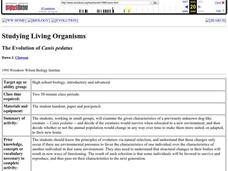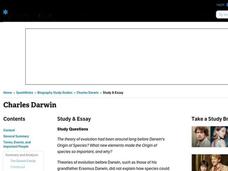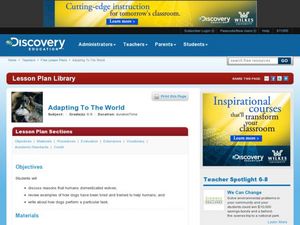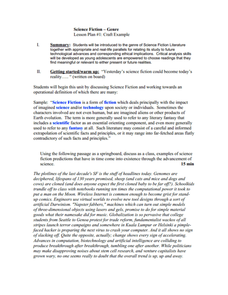University of California
Artificially Selecting Dogs
Selective breeding has resulted in some novel and beautiful or useful dogs over the years. Using the American Foxhound as an example, genetics learners find out how and why they came about. Then, in small groups, they select breeds to...
Curated OER
From Wolf to Dog
Students explain how dogs evolved from wolves based on the video. In this biology lesson, students research about breeding animals for specific traits. They interview dog owners and create a presentation about the dog.
Curated OER
A Dog's Life
Middle schoolers get a look into the life of dogs-from their origins and basic biology, through selective breeding, and into how dogs have become intricate parts of everyday life for many people worldwide.
Curated OER
Introduction to Adaptation
Tenth graders observe collections of specimens and discuss their answers to provided questions. They explore common ancestry, homology, analogy, adaptive radiation, and evolution, while formulating creative answers based on their...
Curated OER
Studying Species By Examining the Evolution of the Canidae Family
Pupils read an article on the characteristics of wolves and dogs then complete a phylogenetic tree of the canid family. They then write an essay justifying why or why not wolves and dogs should be classified as different species.
Howard Hughes Medical Institute
Natural and Artificial Selection
Many people oppose genetically modified foods yet support selective breeding in dogs. Learn about the similarities and differences through a short presentation that features many video clips. It covers natural selection, artificial...
Biology Junction
Lamarck vs. Darwin: Introduction to Change in Organisms
How are traits passed down from parents? Jean Baptiste Lamarck and Charles Darwin envisioned conflicting theories. Learn about both scientists and their theories with an insightful presentation. Giraffes and dogs serve as examples of...
Curated OER
Dogs & Darwin
Ninth graders construct and conduct a laboratory experiment illustrating the transfer of mutations. They compare and contrast natural selection in organisms with long and short reproductive cycles.
Curated OER
The Evolution of Canis pedatus
Students examine the given characteristics of a previously unknown dog-like creature, Canis pedatus, to decide if the creatures would survive when relocated to a new environment. They work in small groups to decide whether or not the...
Curated OER
The Evolution of Canis pedatus
Students, in groups, examine the given characteristics of a previously unknown dog-like creature, Canis pedatus. They discuss whether or not this species would show adaptations and survive if it were relocated to a new environment.
Curated OER
This Place is Going to the Dogs
Students study different breeds of dogs. They watch a video, "Extraordinary Dogs", about special dogs and how they are categorized according to their adaptations. Then they create a digital video that demonstrates the qualities of dogs...
Curated OER
Studying Species by Examining the Evolution of the Canidae Family
Students examine the definition of species. Students complete a phylogentic tree of the Canidae family. They write an essay justifying why or why not wolves and dogs should be classified as different species.
Curated OER
Charles Darwin
In this online interactive history activity, high schoolers respond to 9 short answer and essay questions about Charles Darwin. Students may check some of their answers on the interactive activity.
Curated OER
Adapting to the World
Middle schoolers consider dog breeds that are helpful to humans and their hereditary link to wolves. In this biology lesson, student research a dog breed for traits that make it useful to humans. Students write a report of how these...
American Museum of Natural History
What Do You Know About Horses?
A 10-question online quiz tests scholars' knowledge about horses: all answers come with an informative explanation.
Appalachian State University
Science Fiction - Genre
Unsuspecting George McFlys are presented into the craft workings of the science fiction genre of literature. Speculations are developed through teacher-led dialogs about how science fiction impacts science, technology, and comments on...
Curated OER
Mammals: Mammals and Their Ways
Students study the difference between innate and learned behaviors. They observe the adaptations and behaviors of mammals in this series of lessons.
Curated OER
Curious Crossbreeds
Students discover the diverse roles of hybridization among animals. They research certain examples of animal hybrids as a springboard to analyzing a zoo's potential exhibit of animal hybrids.
Curated OER
Naming New Species
Learners explore science of taxonomy and the Five Kingdoms of life,
categorize organisms into Kingdoms, and create multi-media presentations illustrating knowledge of a Kingdom. They collect data and related pictures on the Internet,...
Curated OER
Investigating Jack London's White Fang: Nature and Culture Detectives
Students explore images of the Klondike and read Jack London's White Fang to become culture and nature detectives. In this novel analysis lesson, students analyze the setting of the novel and the ways London portrays nature and culture....
Curated OER
Where Do I Belong?
Tenth graders study the diversity of life in the world. They classify and sketch organisms into the 6 kingdoms.
Curated OER
Can You Beat Jet Lag?
Learners examine the health condition of jet lag. Using mealworms, they test the effect of light on the development of them into adults. They answer discussion questions and examine the relationship of age and one's activity level.
Curated OER
Basic Genetics
Ninth graders discover where their physical appearance and personality traits come from. In this genetics lesson, 9th graders learn about cells, chromosomes, DNA and genes. Students discover where genes come from as well as dominant and...
PBS
Pbs: Dogs and More Dogs
NOVA takes a comprehensive look at the origin of different species of dogs in this feature. Interesting information like, why do they come in so many shapes and sizes, and why do they have us right where they want us is provided.

























